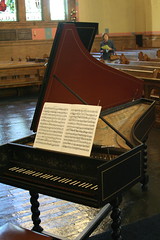A harpsichord is a musical instrument played by means of a keyboard. It produces sound by plucking a string when each key is pressed, says Wikipedia.
Also in the harpsichord family are the smaller virginals, the muselar or muselaar virginals and the spinet (but not the clavichord which is a hammered instrument).
The harpsichord was widely used in baroque music. It became less popular following the invention of the piano, but its distinctive sound is still used in contemporary music.
The harpsichord was most probably invented in the late Middle Ages. By the 1500s, harpsichord makers in Italy were making lightweight instruments with low string tension. A different approach was taken in Flanders starting in the late 1500s, notably by the Ruckers family. Their harpsichords used a heavier construction and produced a more powerful and distinctive tone. They included the first harpsichords with two keyboards, used for transposition.
The Flemish instruments served as the model for 18th century harpsichord construction in other nations. In France, the double keyboards were adapted to control different choirs of strings, making a musically more flexible instrument. Instruments from the peak of the French tradition, by makers such as the Blanchet family and Pascal Taskin, are among the most widely admired of all harpsichords, and are frequently used as models for the construction of modern instruments. In England, the Kirkman and Shudi firms produced sophisticated harpsichords of great power and sonority. German builders extended the sound repertoire of the instrument by adding sixteen foot and two foot choirs; these instruments have recently served as models for modern builders.
In the late 18th century the harpsichord was supplanted by the piano and almost disappeared from view for most of the 19th century.
Tuesday, April 21, 2009
Subscribe to:
Post Comments (Atom)





No comments:
Post a Comment